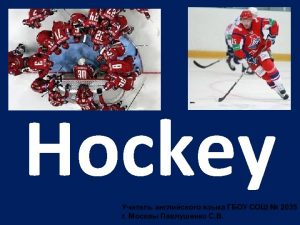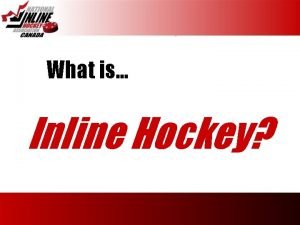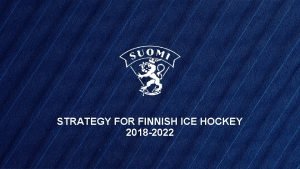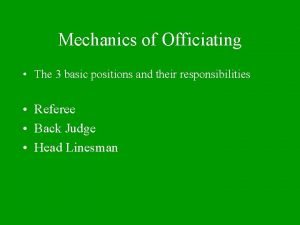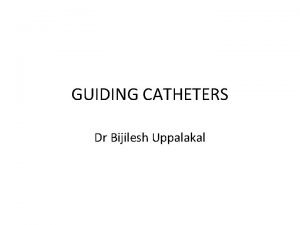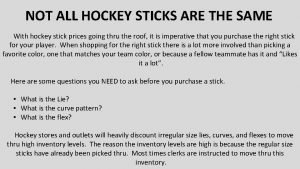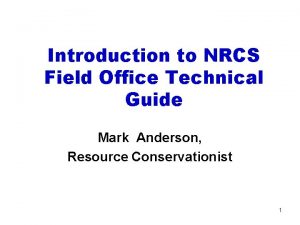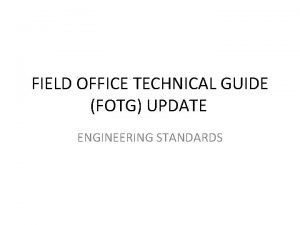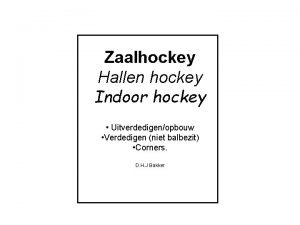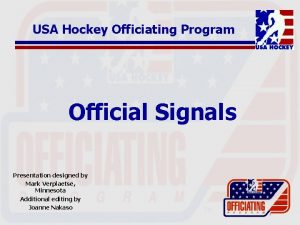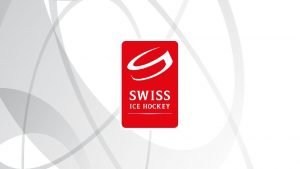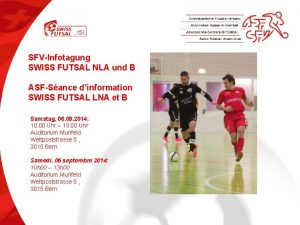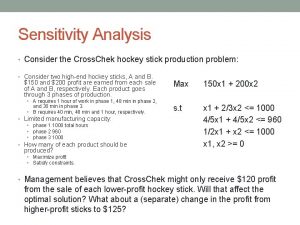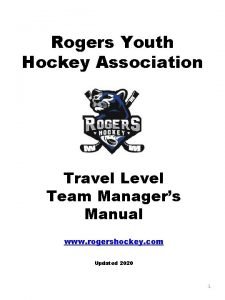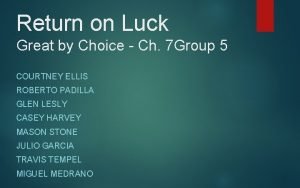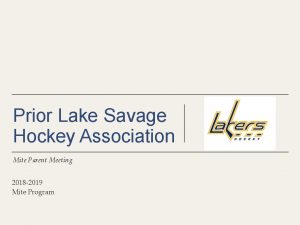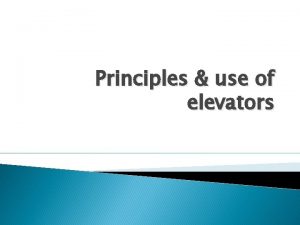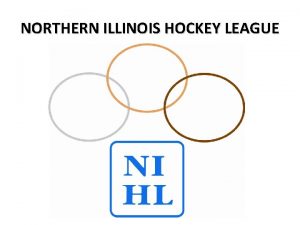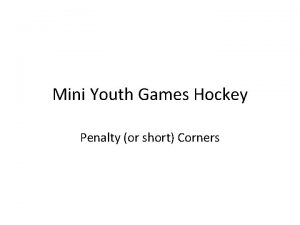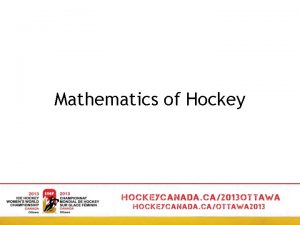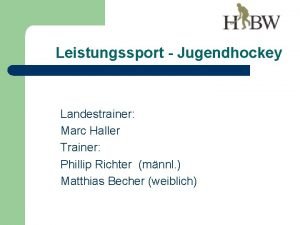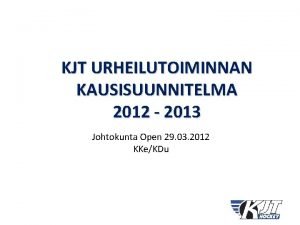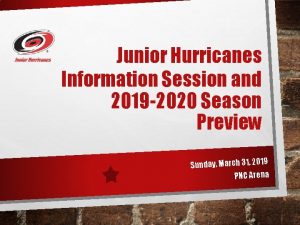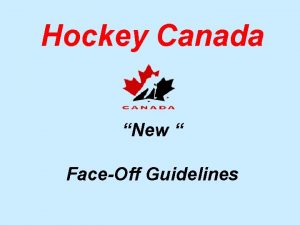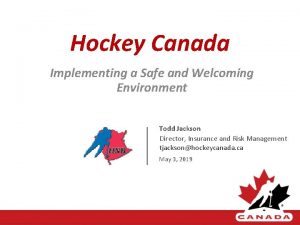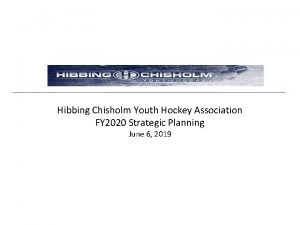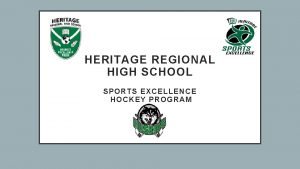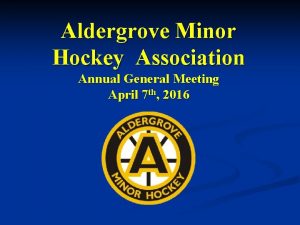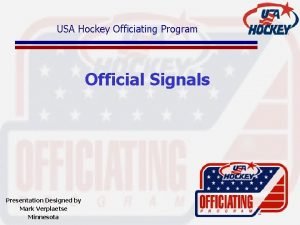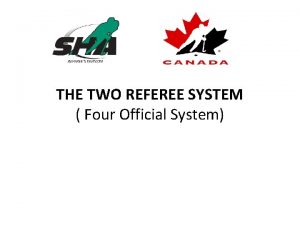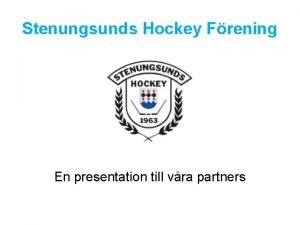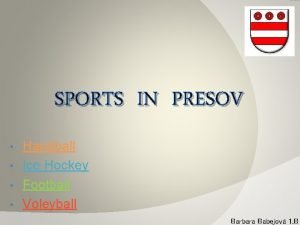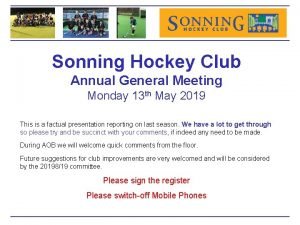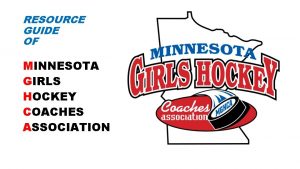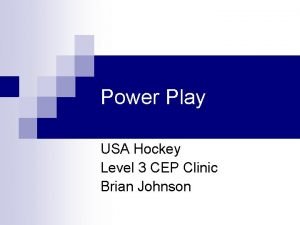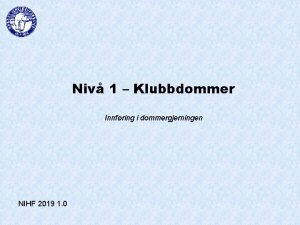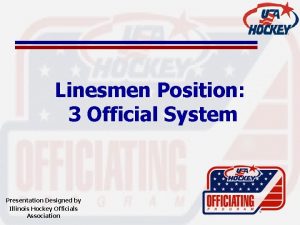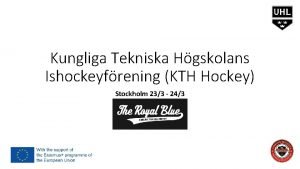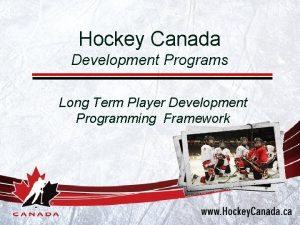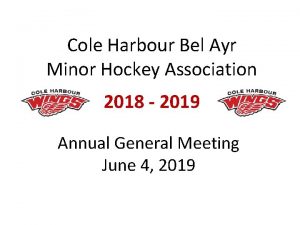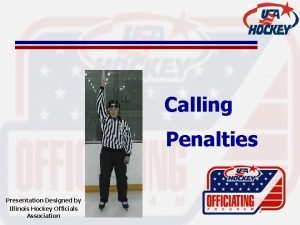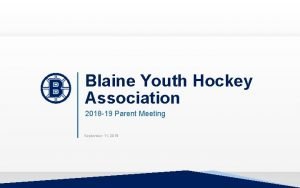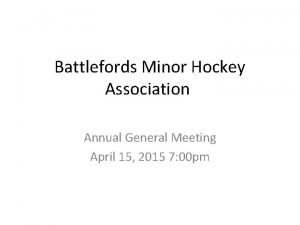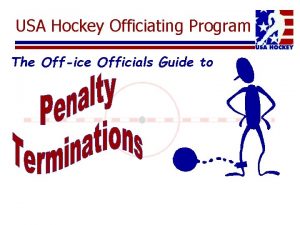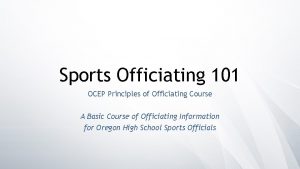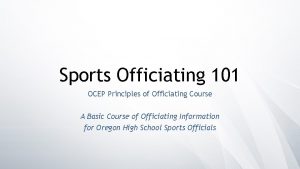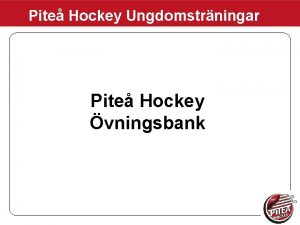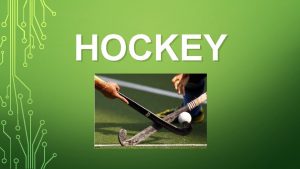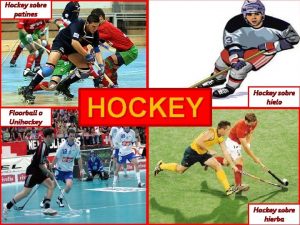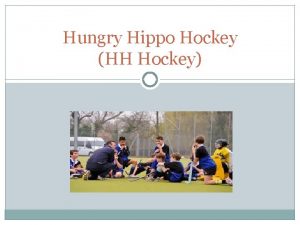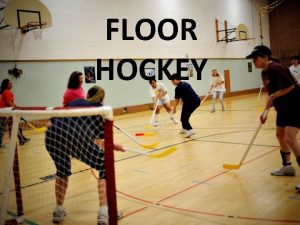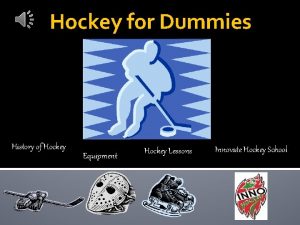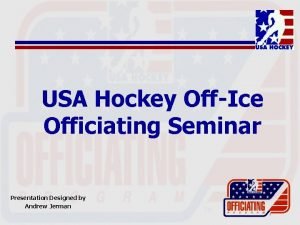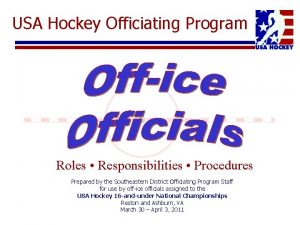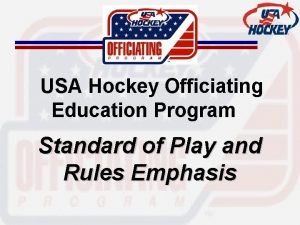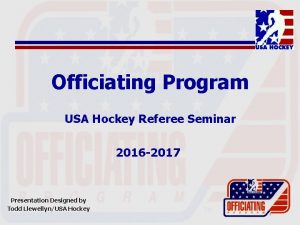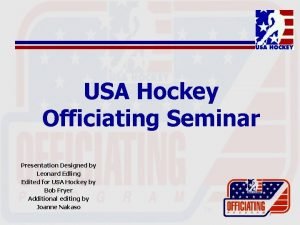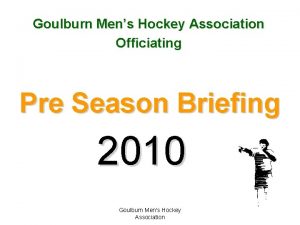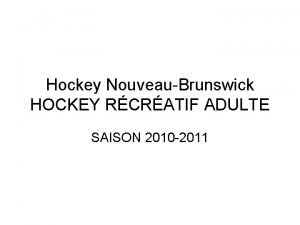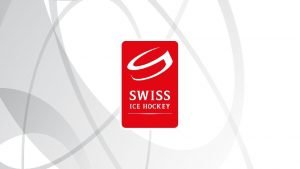Hockey 101 A Guide to OffIce Officiating Created


































































- Slides: 66

Hockey 101 A Guide to Off-Ice Officiating Created by Barry Olson and Kevin Johnson 2009/2011 Rules Updated: 12/2009

General Guidelines • What is the difference between a Referee and a Linesman?

Referee • The “REFEREE” shall have general supervision of the game and shall have full control of all game officials, team officials and players before, during and after the game, including stoppages; and in case of any dispute, their decision shall be final.

Linesman • The duties of the “LINESMAN” are to determine any infractions of the rules concerning off-side play at the blue lines, at the center line, or any violation of the “Icing the Puck” rule – They shall conduct the face-off at all times, except at the start of the game, at the beginning of each period and after a goal has been scored – They shall not stop play to report any penalty except any violation of too many players on the ice and any violation of articles thrown on the ice from vicinity of players’ or penalty bench, and they shall report such violation to the Referee who shall impose a bench minor penalty against the offending team

Off-Ice Officials • The need for off-ice officials varies depending on the level of the competition – Advanced levels of competition (including tournaments) require a larger off-ice staff – Always try to have at least four off-ice officials (six with goal judges)

Dereliction of Duties • On-ice officials have the authority to remove off-ice official(s) from their duties, usually caused by emotional involvement which affects their ability to perform expected duties – Distraction to officiating team or officials • Position must then be filled immediately by a representative from the team who is responsible for appointing the removed individual • Game cannot commence until position is filled

Communications • Communications between on and off-ice officials is vital – Effective communications reflects the competency of the entire officiating team – Address any questions with on-ice officials prior to start of game (Positive rapport) – Do not blow the horn to get an officials attention once the game has started, wait for a stoppage of play

Communications • Do not hesitate to ask for a clarification from the on-ice official (ex. multiple penalties) • Offer your version of an incident only when asked by an on-ice official • Avoid questioning an official’s judgment or showing displeasure with a particular call

Responsibilities • Be courteous and professional at all times • Remain impartial at all times in order to dispel any notions of favoritism and to create a positive playing environment • Serve as a liaison between officials and teams – An extension of the on-ice officiating team – Assist the on-ice crew – Contribute to avoiding conflicts or perceived bias towards one team or the other

Off-Ice Officials Duties Scorekeeping Clock Operation Monitoring Penalty Boxes Announcing

Official Scorer • Secure game roster prior to start of game – No player can be added to the scoresheet once play commences without penalty • Consult on-ice official for instructions – Maximum of 20 players to be listed on scoresheet

Official Scorer • Ensure Head Coach is identified as well as additional team officials (maximum of four) in players box – Ensure CEP number, level, and year obtained are listed on scoresheet

Official Scorer • Ensure Captain and Alternate Captain(s) (maximum of two) are designated on scoresheet next to their name

Official Scorer • Record goals, assists, and penalties as reported by Referee – Be sure to record period goal was scored, time of goal, number(s) of player(s) credited with goal and assist(s) – Record the time based on the amount of time that has expired in the period (ex. clock shows 10: 00 remaining in 15: 00 period – recorded as 5: 00)

Official Scorer • Scoring information shall be recorded for type of goal (ex. (E) empty net, (PP) power play, or (SH) short hand in appropriate box on scoresheet • Once reported by Referee, no changes can be made to who gets credit for goals or assists without approval of the on-ice officials

Official Scorer • Penalties reported by Referee shall be recorded by period, team, player number, type (minor, major, misconduct, etc. ) or length (2: 00, 5: 00, 10: 00 etc. ), and type of infraction (tripping, holding, hooking, etc. ) – Record the time based on the amount of time that has expired in the period (ex. clock shows 10: 00 remaining in 15: 00 period – recorded as 5: 00)

Official Scorer • Work closely with penalty bench attendants to ensure penalized players are released at the appropriate times – Properly communicate penalty expiration situations • A signal such as 10 seconds left on the home team penalty may be used

Official Scorer Special Penalty Situations • When both teams are at equal on-ice numerical strength, no penalty can expire as the result of a goal • The penalty that expires is the minor or bench minor penalty then being served with the least time remaining on the penalty clock.

Official Scorer Special Penalty Situations • When a misconduct penalty is called, no time is recorded on clock – It is easiest to write down the time of expiration on a piece of scrap paper to avoid confusion • Penalty cannot terminate due to a goal being scored by opposing team, player must always serve full penalty • When a minor plus misconduct penalty is called against a player, the team incurring the penalty must place an additional player in the penalty box to serve the minor portion of the penalty

Official Scorer Special Penalty Situations • A major penalty cannot expire as the result of a goal scored • For a major penalty and game misconduct the offending team is not required to immediately place a substitute on the penalty bench and may do so prior to the expiration of the penalty

Official Scorer Special Penalty Situations • A double minor penalty is always treated as two separate minor penalties, not one four-minute penalty

Official Scorer Special Penalty Situations • Player is assessed two penalties during the same stoppage of play – Second penalty does not start until the first penalty has expired or terminated as the result of a goal

Official Scorer Special Penalty Situations • Major and minor penalty assessed to same player – When a player receives a major penalty and a minor penalty at the same time the major penalty shall be served first by the penalized player

Official Scorer Special Penalty Situations • Two players of same team receive minor penalties – When the minor penalties of two players of the same team terminate at the same time the Captain of that team shall designate to the Referee which of such players will return to the ice first

Official Scorer Special Penalty Situations • Official is signaling a penalty and opposing team scores – The signaled penalty is written in the scorce book but the player does not serve the penalty – The signaled penalty is assessed but the penalty being served (if applicable) is terminated – One minor penalty terminated is the maximum allowable for one goal scored

Official Scorer Special Penalty Situations • Two players from same team are serving minor penalties and opposing team scores – Terminate the minor or bench minor penalty with the least time remaining on the clock.

Official Scorer Special Penalty Situations • Five minor penalties to same player – Any player who incurs five penalties in the same game shall be assessed a game misconduct penalty – Note: Do not tell the referee when players have 3 or 4 penalties

Official Scorer Special Penalty Situations • Two major penalties to same player – For the second major penalty in the same game to the same player or goalkeeper, that player shall be assessed a game misconduct penalty in addition to the major penalty

Official Scorer Special Penalty Situations • A team incurs fifteen penalties during same game – Any Head Coach whose team receives 15 or more penalties during one game shall be suspended for the next one game of that team.

Official Scorer • At the end of each period and the end of the game, record Goaltender shots on goal and saves

Official Scorer • Keeping track of shots on goal

Official Scorer • Upon conclusion of game, check scoresheet completely for accuracy and neatness – On-ice officials should cross out all portions of scoresheet that have not been used to prevent information from being added at a later date – The scoresheet is not complete until signed by official scorer and on-ice officials

Official Scorer • Distribute a copy to each team after game (White Copy) Office (Yellow Copy) Home Team (Pink Copy) Visitors

Game Timekeeper • Check operation of clock prior to game to insure clock is functioning properly • Place appropriate warm-up time on clock (5 minutes) prior to teams entering ice and start time immediately once both teams have entered ice • Respond to on-ice official’s check prior to start of each period to signal you are ready to start game

Game Timekeeper • Stop and start clock at appropriate times • If for some reason the clock is not stopped or started at the appropriate time, the game timekeeper should immediately do so when brought to their attention – A mental note should be made as to an estimate of how much time elapsed and this time relayed to the on-ice officials at the next stoppage of play

Game Timekeeper • All penalties which require a team to play shorthanded should be placed on the penalty clock – Excludes coincident penalties – Excludes misconduct penalties

Game Timekeeper • When a goal is scored which results in the termination of a penalty appearing on the clock, the game timekeeper shall remove the time prior to play commencing • Shall announce on the public address system at the appropriate time in each period that there is one minute remaining to be played in the period

Game Timekeeper • Ensure horn is sounded at conclusion of each period • Prior to start of third period, research the tournament rules and confirm with on-ice officials as to the use of running time – Running time is only used in the third period

Game Timekeeper • If a six goal differential exists at any time during third period “Running Time” will commence (Check with local association rules) – Stop time will resume if the goal differential is reduced to 4 • Despite the occurrence of running time, penalties will remain the duration prescribed by USA Hockey rules – Clock is stopped only in situations when a goal is scored, a penalty is assessed, there is an injured player, or other unusual delay (rink defect, etc. )

Game Timekeeper • When time has been stopped under these conditions, the clock shall be restarted upon completion of the ensuing face-off • If a stoppage occurs and time elapses of players in the bench box they must wait until play resumes to return

Penalty Bench Attendant • Open and close door for penalized player • Monitor behavior in and around the penalty bench and scorer’s bench – Penalized player must not incite opponent – No obscene or vulgar language – No disrespect to officials (on and off-ice) – Do not allow spectators or officials to harass penalized players

Penalty Bench Attendant • Any unsportsmanlike actions need to be reported to on-ice official during the next stoppage of play • Undivided attention to game in progress – May be asked by official scorer to assist with shots on goal or save count

Public Address Announcer • Verbal communications link between the game official and spectators • Check with representative of each team prior to start of game to pronounce or clarify enunciation of difficult names • Responsible to announce goals, assists, penalties, and other pertinent information as it pertains to the game

Public Address Announcer • Make special announcements – (ex. sportsmanship rules, line ups, etc. ) • Announce visiting team information first followed by home team

Public Address Announcer • When announcing goals and assists, it is important to only announce the players who are actually being credited with the goal and assists as reported by the referee (ex. time of goal, number and name of goal scorer, number(s) and name(s) of the player(s) being credited with assist(s) – If the goal was unassisted, announce that

Public Address Announcer • When announcing penalties, the time, team player number and name of penalized player, type of penalty (minor, major, misconduct etc. ) and the infraction all need to be announced • At the end of each period, the announcer will announce the score and the shots on goal and/or saves for each team • It is important to stop music (if playing) prior to play resuming

Official Signals • Boarding: Pounding the closed fist of the non-whistle hand into the open palm of the other hand

Official Signals • Butt-Ending: Moving the forearm, fist closed, under the forearm of the other hand held palm down

Official Signals • Charging: Rotating clenched fists around one another in front of chest

Official Signals • Checking from Behind: Non-whistle arm placed behind the back, elbow bent, forearm parallel to the ice surface

Official Signals • Cross-Checking: A forward motion with both fists clenched extending from the chest

Official Signals • Delaying the Game: The nonwhistle hand, palm open, is placed across the chest and then fully extended directly in front of the body

Official Signals • Elbowing: Tapping the elbow of the whistle hand with the opposite hand

Official Signals • Grasping the Face Mask: Closed fist held in front of face, palm in, and pulled down in one straight motion

Official Signals • High-Sticking: Holding both fists, clenched, one immediately above the other, at the side of the head

Official Signals • Holding: Clasping the wrist of the whistle hand well in front of the chest

Official Signals • Hooking: A tugging motion with both arms, as if pulling something toward the stomach

Official Signals • Interference: Crossed arms stationary in front of chest with fists closed

Official Signals • Kneeing: A single tap of the knee (non-whistle side) with the non-whistle hand, keeping both skates on the ice

Official Signals • Match Penalty: Pat flat of hand on the top of the head.

Official Signals • Misconduct: on hips one time Placing of both hands

Official Signals • Roughing: With the non-whistle hand, one punching motion to the side with the arm extending from the shoulder

Official Signals • Slashing: One chop with the nonwhistle hand across the straightened forearm of the other hand

Official Signals • Spearing: A single jabbing motion with both hands together, thrust forward from in front of the chest, then dropping hands to the side

Official Signals • Tripping: Strike the side of the knee (non-whistle side) and follow through once, keeping the head up and both skates on the ice

Official Signals • Unsportsmanlike Conduct: Use both hands to form a ``T'' in front of the chest
 Field hockey vs ice hockey
Field hockey vs ice hockey Inline hockey vs ice hockey
Inline hockey vs ice hockey Ice hockey vs hockey
Ice hockey vs hockey Inline hockey vs ice hockey
Inline hockey vs ice hockey Mechanics of officiating position singles and movement
Mechanics of officiating position singles and movement Numbers in basketball
Numbers in basketball 3 man officiating coverage
3 man officiating coverage Dead ball officiating in football
Dead ball officiating in football Officiating track and field
Officiating track and field Ar catheter full form
Ar catheter full form Hockey stick lie
Hockey stick lie Nrcs fotg
Nrcs fotg Field office technical guide
Field office technical guide Factory office plan
Factory office plan Hockey verdedigen oefeningen
Hockey verdedigen oefeningen Acrostic poem for hockey
Acrostic poem for hockey Feht hockey
Feht hockey Hockey ref penalty signals
Hockey ref penalty signals Markus graf eishockey
Markus graf eishockey Delayed offsides hockey
Delayed offsides hockey Sid the kid hockey
Sid the kid hockey Sanitätskoffer hockey
Sanitätskoffer hockey Cross chek
Cross chek District 10 hockey
District 10 hockey Return on luck
Return on luck Prior lake hockey association
Prior lake hockey association Principle of elevators
Principle of elevators Northern illinois hockey league
Northern illinois hockey league Toothless hockey players
Toothless hockey players Minnetonka youth hockey association
Minnetonka youth hockey association Short corner in hockey
Short corner in hockey Field hockey dimensions
Field hockey dimensions Marc haller hockey
Marc haller hockey Kerholeijona
Kerholeijona Nagib ward hockey
Nagib ward hockey Acrostic poem for sports
Acrostic poem for sports What is the slot in hockey
What is the slot in hockey Hockey face-off locations
Hockey face-off locations Todd jackson hockey canada
Todd jackson hockey canada Hibbing youth hockey
Hibbing youth hockey Heritage high school hockey
Heritage high school hockey Hockey positions
Hockey positions Barringtons hockey
Barringtons hockey Supplements for field hockey
Supplements for field hockey Aldergrove minor hockey
Aldergrove minor hockey Woodbury hockey association
Woodbury hockey association Usa hockey penalty signals
Usa hockey penalty signals Hockey referee positioning 2 man system
Hockey referee positioning 2 man system Stenungsunds hockey
Stenungsunds hockey Presov handball
Presov handball Sonning hockey club
Sonning hockey club Richard dean anderson hockey
Richard dean anderson hockey Premier prep league
Premier prep league Cep level 2
Cep level 2 Dommerdagbok hockey
Dommerdagbok hockey Mosinee hockey club
Mosinee hockey club Linesman positioning hockey
Linesman positioning hockey Kth hockey
Kth hockey Poetic techniques repetition
Poetic techniques repetition Majestic oaks boot hockey
Majestic oaks boot hockey Majestic oaks boot hockey
Majestic oaks boot hockey Hockey canada development model
Hockey canada development model Cole harbour minor hockey
Cole harbour minor hockey Hockey penalty signals
Hockey penalty signals Blaine youth hockey
Blaine youth hockey Cricket hockey billiards fencing
Cricket hockey billiards fencing Battlefords minor hockey
Battlefords minor hockey
